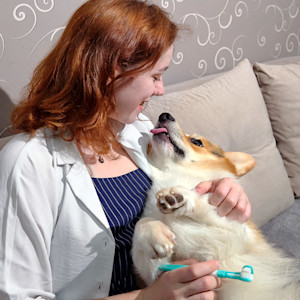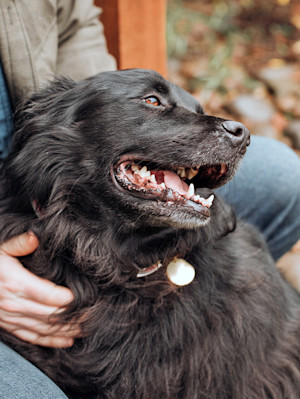Why Are My Dog’s Gums Black?
Know if or when you should be concerned.

Share Article
In This Article:
Are Black Spots on a Dog’s Gums Normal? Why Are There Black Spots on My Dog’s Gums? What Colors Should My Dog’s Gums Be? How To Treat Black Spots on My Dog’s Gums
There can be many reasons for a dog to have black coloration on their gums, and the good news is that most of the time, this can be perfectly normal. The gums are specialized tissue that cover the jaw bones and create a protective interface at the base of the teeth. This tissue serves many important roles to protect the underlying teeth and bones.
It also contains a network of blood vessels and nerves. Problems with the gums can be an indication of problems with the underlying teeth, bones, blood supply, and/or nerves. It’s important to pay attention to your dog’s gum health, as it offers clues to many other underlying conditions. Read on to learn how to evaluate your dog’s gums to understand what is normal and when to seek veterinary care.
Are black spots on a dog’s gums normal?
It’s happened to all of us: You pry your dog’s mouth open because they nabbed something they shouldn’t be eating. You get an up-close look at all the nooks and crannies of their mouth that you don’t normally see. Then you suddenly notice a black spot. Was it always there, and you just never looked back there before? Or is this a new spot that popped up overnight?

Before you panic, try to characterize what you're seeing and take note of how the gums around this area look. Is the spot flat or raised? Are the surrounding tissues red, swollen, or bleeding? Many times, a flat, pigmented spot on the gums is nothing to worry about, but there are some important details to consider. If you are ever in doubt, it’s best to see a vet to get an expert’s perspective.
Why are there black spots on my dog’s gums?
There are a number of reasons why a dog might have black spots on their gums. The most common explanation is simply normal variations in pigmentation. Some dogs will have black spots on their gums or completely black gums. Usually, they are born this way, but sometimes they can develop changes in the pigmentation of their gums or tongue within the first few months of puppyhood and even into adulthood.
Other times, sudden changes in gum pigmentation can indicate a medical condition. If you notice a change in your dog’s gum color, try to evaluate it in the context of their overall health. If your dog also has swelling, bleeding, or other changes to their gums or teeth, this is abnormal. Additionally, if your dog has any signs of systemic illness, like shortness of breath, lethargy, loss of appetite, or collapse, this is also further evidence that there is a serious underlying medical condition. Be sure to see a vet if you notice any of these signs. Some of the possible causes for black spots on the gums include:
Normal pigmentation
For many dogs, black pigmentation on their gums or tongue can be completely normal. During fetal development, pigment cells randomly migrate to their permanent locations and may result in freckle-like spots in the mouth as well as on the body. Because these patterns are random, offspring, parents, and siblings will all have their own unique patterns. Even genetically identical clones will have different patterns from each other.
Dog breed
Certain breeds are known for having pigmented gums and/or tongues and this is a completely normal variation. This is common in breeds like Shar Peis, Chow Chows, Pomeranians, Akitas, Thai Ridgebacks, German Shepherds, Huskies, Golden Retrievers, and Labrador Retrievers. It can also happen randomly in dogs of any breed.
Melanoma
This is a type of pigmented tumor that can be found in the mouth or on the skin,and is the reason that it is important to keep an eye on any new pigmented spots that develop in the mouth or on the body. Melanoma is an aggressive form of cancer. If a new spot shows up suddenly and seems to be changing in size or shape, it is important to see a vet. This is especially true if the spot is raised or bleeding.
Periodontal disease
Any abnormalities in the tissues surrounding the teeth are collectively known as periodontal disease and this includes conditions that inflame the gums, known as gingivitis. Most of the time, these conditions do not cause the gums to turn black, though The main changes you’ll see with periodontal disease are red, swollen gums that may bleed more easily. There may also be obvious signs of tooth decay or loose or missing teeth. These dogs may also have bad breath, chatter their teeth, drool, or have difficulty chewing hard food or toys.
Periodontal tumors
There are many other kinds of tumors that can develop in the mouth in addition to melanomas. Most of these are not typically associated with black spots in the mouth but they are often areas of swelling and may appear red or bleeding.
Some of the most common cancerous tumors of the mouth in dogs are melanoma, squamous cell carcinoma, and fibrosarcoma. There are also many kinds of benign tumors that can develop in the mouth that will not cause cancer including fibromas and epulis. In nearly all cases, a biopsy is necessary to determine what kind of tumor is present.
Cyanosis
Conditions that reduce the amount of oxygen in the blood may result in cyanosis, or a bluish tint to the skin and gums. On some dogs, this can make their gums look darker and less pink. This is a medical emergency and is always accompanied by other signs of serious illness including difficulty breathing, lethargy, and/or collapse.
What colors should my dog’s gums be?
Normal dog-gum color ranges from bubble-gum pink to completely black or black spotted. No matter the color, gently pressing on their gums should blanch the color to white before very quickly returning to normal in less than two seconds. For dogs with black gums this can be more difficult to tell.
Gums that are pale pink or white, bluish, or very dark red can all be signs of a bigger problem. These changes point to a systemic health problem relating to their circulation, oxygenation, or blood counts, and are accompanied by more serious signs of illness.
Changes in the color or texture of the gums in one specific spot can be a sign of a more localized problem, related to that portion of the mouth. This can happen if there is a damaged tooth, gingivitis, a traumatic injury to the mouth, or a tumor. In general, you can help to support your dog’s gum health and overall oral health by regularly brushing their teeth and following your vet’s recommendations for dental cleanings.
How to treat black spots on my dog’s gums
In most cases, if your dog has always had a black spot on their gums or their gums are diffusely black, no treatment is necessary. This is their normal pigmentation, and it won’t change. If you do notice that your dog has a new spot on their gums that concerns you, the best thing to do is see your vet to determine if additional steps, like a biopsy, are necessary. Some steps you can take to keep your dog’s teeth and gums healthy are:
Home dental care
Build daily tooth brushing into your dog’s routine. It may take some time for them to accept this, especially if you have an older dog that hasn’t brushed before. Start slowly by just letting your dog taste the toothpaste and reward your dog for letting you put the toothbrush in their mouth. Try to make this a positive experience by using lots of praise and rewards so that your dog will get comfortable with this new chore.
Avoid extra hard chew toys
Try to select chew toys made from firm rubber that will be gentler on your dog’s teeth. Extremely hard substances, like ice, rocks, and certain bones can cause excessive wear on your dog’s teeth and may even lead to cracks or fractures in their teeth. These injuries can be painful and lead to inflammation and infection of the surrounding gums.
Regular check ups
Be sure to keep up with your dog’s regular check-ups and preventative medical care. These opportunities allow your vet to look for any changes in their gums or teeth and to make recommendations for additional care like dental cleanings, X-rays of the teeth, or extractions of any broken teeth in order to keep your dog feeling their best.
Bottom line:
Black spots or completely black gums are normal for many dogs.
Try to take note of any other changes such as swelling, bleeding, or rapidly growing growths in the mouth as these should be checked out by a vet.
You can promote good oral health in your dog by keeping up with regular tooth brushing and preventative vet care.
References
“Canine periodontal diseaseopens in new tab.” USDA APHIS, February 2024.
Conroy, J, et al. “The Development Of Cutaneous And Oral Pigmentation In Labrador Retriever Fetu Es (Canis Familiaris)*opens in new tab,” Journal of Investigative Dermatology, vol. 54, no. 4, 1970, pp. 304-315.
“Melanoma & Melanocytic Tumors In Dogsopens in new tab,” The National Canine Cancer Foundation.
Mulherin, B. “Oral Tumors in Small Animalsopens in new tab.” Merck Veterinary Manual, November 2024.
Yang, H, et al. “The origin of chow chows in the light of the East Asian breedsopens in new tab,” BMC Genomics, no. 174, 16 February 2017.

Dr. Amy Fox, DVM
Amy Fox, DVM is a small animal veterinarian in New York City with over thirteen years of experience in a mixture of general practice, emergency medicine, and shelter medicine. A lifelong animal lover, Dr. Fox studied biology in college and then worked as a veterinary nurse before pursuing veterinary school at Cornell University. Her expertise includes surgery, dentistry, and management of chronic conditions, and she is interested in toxicology, pain management, nutrition, care of senior pets, and educational outreach. Dr. Fox also enjoys writing about veterinary medicine and teaching, and her work has previously appeared in Spruce Pets. In her free time, she loves to cook, garden, go for long runs, and hang out with her goofy mixed-breed dog May, who provides never ending comic relief!
Related articles
![Woman brushing her small white dog's teeth.]()
How to Brush Your Dog’s Teeth
And other tips to make sure your dog’s teeth are as healthy as possible.
How Much Does Dog Teeth Cleaning Cost?
Real talk: Your pup’s dental health is a necessary expense.
![Brown poodle dog's teeth chattering.]()
Why Are My Dog’s Teeth Chattering and What to Do
We can help you get to the bottom of the issue.
What Is the Best Way to Clean a Dog’s Teeth?
![Man hugging his large fluffy black dog outside.]()
Plaque vs. Tartar in Dogs’ Teeth
Understand the difference to take steps to eliminate them both.
![Closeup portrait of fun corgi dog laying in the bed, looking at camera.]()
Your Dog Is Grinding Their Teeth: What This Means and What to Do
It probably indicates that something is awry.







